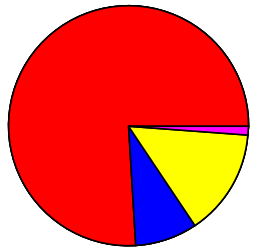The problem with pie charts
is that they don't allow the visualization or the possibility of something else, something that is unknown, or undefined. They can only show some measure of allocation of the pieces of a thing that can be identified and named.
Even the pie charts that have 'other' or 'undefined' as a component or slice, still have the overall context of the chart to set the definition. The 'other' slice of most every pie chart is not really 'unknown' anyway, it just means that there were too many additional defined things that bothering to chart them all individually just made no sense or was not visually appealing.
But we like pie charts, I think, because we like to classify and identify things, and we like even more to have the things we classify and identify sum up into a tidy and logical package. There is that thing, or process, or amount, or opportunity that we have to examine and describe and the way that we feel most comfortable and capable addressing this problem is to separate, partition, and sum. And to make sure that nothing is missed, nothing is unknown, nothing is indeterminate.
I think this is probably the cause of another, and related, truth (one we don't like to admit either), that the vast majority of your peers don't actually want you to be successful, as it would mean in the logic of the pie chart, that they are losing. They want to keep the size of their piece of the pie as large as possible, and ceding any area to you or anyone else can only diminish their status or income or opportunity. Sure we can talk about 'making the pie larger for everyone' but we almost never think that way when we encounter news of someone else getting a great new job or landing a big account or signing up a new sponsor.
Even in markets where actually determining the absolute total size of the pie, (say for example, all the potential organizations that might hire you to speak to their employees or customers or prospects) the instant you find out that someone else just got hired by company 'X' to work on 'Y', you lament the missed opportunity. And while in that narrow, slice of the pie context you might be correct, spending more than one second trying to re-calibrate your relative position compared to the market (which you can't know how large it really is anyway), is foolish.
Forget the pie, forget trying to grab a progressively larger share of some fixed and finite thing. Do what you do and if it is honest enough, and good enough, you will have your own pie. And you will finally stop caring about what everyone else is doing.
They will still hate you though.
Have a great week!

 Steve
Steve
Reader Comments (4)
I agree on the fact that pie charts provide the overview rather than detail. Pie charts are popular because they are easy fro both who creates and who studies.
I'm going to point it. this is great.
bajrangi bhaijaan total earnings
good
great article
it is helpful to me